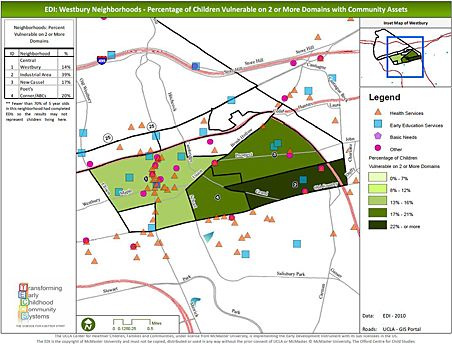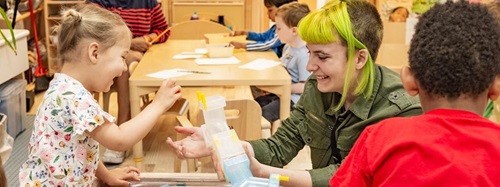Community Partnerships for Assuring School Readiness
| December 2014This is an exciting time for early childhood education. Politicians on both sides of the aisle in small towns, big cities, and the nation’s capital are supportive of greater government investments in young children. Up to now, one of the biggest stumbling blocks to increasing funds for early childhood has been the lack of public will. We seem to have finally reached the tipping point for that. The next challenge is designing funding policies that can leverage community assets and partnerships to create high quality learning environments that help all children reach their potential.
After working in early childhood policy for 30 years at the national level, I have spent the past 10 years working locally to improve school readiness and success and engage a range of community stakeholders in the enterprise. What an education! It is abundantly clear how some policies are actually impediments to creating comprehensive, high-quality services for young children, and are often ignorant of the ways communities work. The informal spaces in a community that provide significant support to families, such as churches, libraries, pediatricians’ offices, and parks, are often overlooked as part of the delivery system, thus alienating the very agencies most trusted by local families. Furthermore, services needed to address “the whole child” come from different government agencies and are not easily implemented in all settings. Early childhood advocates have long known that we lack systems and infrastructure to deliver comprehensive services to children and their families, but what can we do to fix the problem?
This work must be done in the context of the larger environment—the political, social, and cultural context of the community. The Early Years Institute on Long Island developed a system of interventions for key community entities across our region that succeed regardless of public policy. We then selected a pilot community, Westbury, and worked with a range of community entities to implement all of the strategies that have proved successful.
We were faced with a number of challenging circumstances in Westbury, where many immigrant families live: poverty (despite parents holding multiple jobs), limited English proficiency and illiteracy, multiple families living in one home, and misconceptions about how school districts works. The challenges required the support of many agencies, and the community was ripe for development. But how we would know we were successful; how would we know we were improving outcomes for children?
The Early Development Instrument (EDI) is a comprehensive “whole child,” school readiness tool gaining traction around the world and in the U.S. More than just an assessment, it is an effective tool to engage communities and improve early childhood service systems. Data shows that the EDI is a valid indicator of school readiness and can predict basic skills performance through fifth grade. Researchers at the Offord Centre in Canada developed the EDI in order to have a more appropriate measure of school readiness in a specific community, one that empowers community-level interventions across multiple systems.
Rather than testing children, the EDI is based on teachers’ observations three to five months into the Kindergarten year. Teachers complete a 120 item survey for each child in about 10-15 minutes, “whole child” measures in 5 domains: (a) physical health and well-being, (b) social knowledge and competence, (c) emotional health and maturity, (d) language and cognitive development, and (e) general knowledge, communications skills and approaches to learning. These are consistent with the national school readiness goals.
What is most unique about EDI is that no individual child is identified on the EDI or shared with the schools. The data are not reported back by student, classroom, or school. Instead, the data are reported back by neighborhood in the form of colorful maps which help the community focus on specific areas of need in identified parts of the community.
EDI Results in Westbury
Teachers completed the EDI on all Kindergarten children in March 2010 and again in March 2012. There were some improvements in 2012 among the children who are “very ready” for school. However, the number of children who are vulnerable in the various domains of school readiness increased in all but one area. The 2012 data showed that 58 percent of children in Westbury do not have the requisite skills for Kindergarten in the area of communications and general knowledge; 48 percent of children are not ready in the area of pro-social and helping behaviors; 35 percent are “not ready” in the area of small and gross motor activities; and one quarter of children are not ready in the area of language and cognitive development.
The map below is how the data are reported back to the school and community. We have one map for each domain of school readiness. The figure shows a map of Westbury and the four neighborhoods where kindergartners in the sample lived. The darker the green area, the more children were found to be not ready for kindergarten in at least two of the five areas of school readiness. The colored geometric shapes represent our Asset Mapping of health, child care and other services that support families. It clearly shows that the children who are most vulnerable are living in neighborhoods where there are the fewest services.
How were we to address this lack of services, and its resulting negative impact on children? We began our work by using principles of Asset-Based Community Development (ABCD), a strategy for providing the most dignified way to leverage the skills of residents, the power of associations, and the supportive function of institutions to build on existing assets and collectively improve outcomes. The ABCD process led to the formation of the Westbury Early Learning Leadership (WELL) Team to review the data and start making changes in response. Over four years, the WELL Team grew from 15 members to over 90 representatives including parents, the schools, child care programs, library, health clinics, religious institutions, business leaders, and elected officials. These groups have helped make presentations about the EDI data, hosted fairs and events with a school readiness table, and partnered with their colleagues to offer early childhood experiences to children and their families that will improve school readiness. The Westbury Early Learning Leadership Team has overseen the implementation of over 25 interventions, for example:
- Changes to kindergarten registration process that have helped more children start school on the first day
- 50 students from Old Westbury College volunteering twice a week in kindergarten where class size hovers around 30 children
- Library staff present at registration for kindergarten and pre-k to sign up children and parents for library cards
- Concept plans for an Outdoor Nature Explore Classroom, an all-natural playground that stimulates all the senses in a part of town with limited safe spaces
- Children’s Reading Corners at the Yes We Can! Community Center and at the Consulate for El Salvador (where many Westbury families are from)
- School supplies for pre-k children to practice fine motor skills the summer before kindergarten
- Work by Docs for Tots to encourage more developmental screenings
In addition to these initiatives, The Early Years Institute helped create the Ready, Set, Achieve! Fund to distribute $75,000 in grant awards to community organizations whose proposals focused on reducing the vulnerabilities found in the EDI. The proposal review committee was chaired by members of the local Chamber of Commerce and also included elected officials and parents. This was a critical decision because committee members became deeply aware of the challenges facing children in the community and familiar with the extraordinary agencies trying to address them. Nine grantees were chosen whose programs will reach over 500 children and families in the Westbury community. They include a project where the school and a local church partnered on a Parent and Toddler Club; the local Head Start program welcoming reading buddies from the NAACP; the Girl Scouts of Nassau County to promote cultural diversity in Kindergarten; and a church-sponsored summer workshop series for Latina mothers. To encourage partnerships, grant awards ranged from $1,000 to $7,500 for a single organization and $10,000 for organizations that applied in partnership with another group. At the Leadership Team meetings, these groups compare their efforts and learn from each other–as it should be.
Conclusion
Across the nation, only half of children under the age of 5 are in the formal, regulated market of child care, Head Start, pre-k, or nursery schools. Therefore, most children are with parents, other family members, and neighbors for much of their care and education during the most critical period of brain development. It is very challenging to reach all families with preschoolers and provide them with information about how to stimulate healthy development for their children. Saturating the community to reach all parents of preschoolers before they arrive at kindergarten requires the engagement of many institutions: child care programs, pediatricians, health clinics, libraries, schools, and others. The realities of family life today compel multi-pronged, multi-agency efforts to improve school readiness at the community level. This requires interventions within and across a range of community institutions that touch the lives of children and families.
EDI is an easy to use, valid, and reliable tool that provides a census of need, offers data reports by neighborhood, and provides a baseline from which to compare communities and measure change over time. Most importantly, it is effective in galvanizing all segments of the community in which children develop. No data, no problem, no action!








